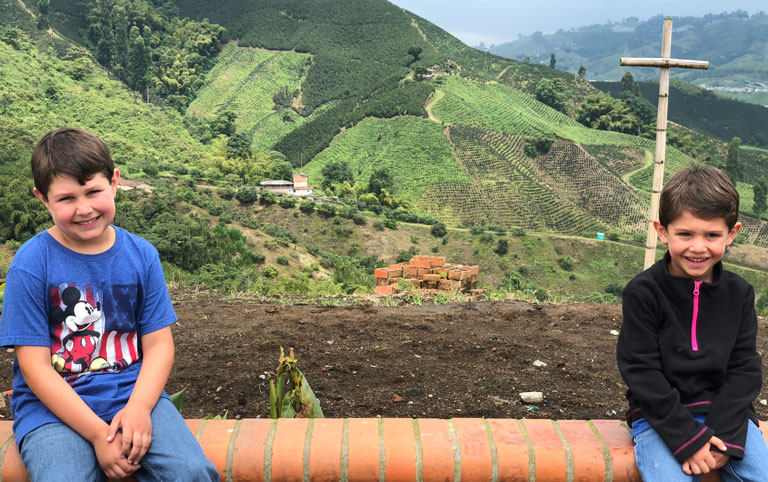Our family vacation this year is to Colombia, South America, to visit relatives and learn Spanish. Thankfully, we’re staying with family the whole time. With no hotel expenses, our six-week trip will cost little more than a trip to Florida!
Bienvenido A Colombia
In contrast to the image most Americans have of Colombia, two-thirds of the country and all of the major cities are in the mountains. We’re talking big snow-covered mountains with Swiss-style chalet retreats. For example, the ground elevation in Bogota is 8,660 feet or 1/2 mile higher than Denver. Although our visit is closer to the equator, it’s still in the mountains. Even close to the equator, those with the means to live at higher altitudes can escape the tropical heat.
Language & Family
Of all the many reasons to visit Colombia, this trip is about family and language. It’s time for our boys to reacquire the Spanish language they’ve been exposed to since birth. That will enable them to talk with their relatives while enjoying many other benefits of knowing Spanish.
Starting Points
My wife speaks perfect Spanish and English with no detectable accent in either language. Her parents have an accent in Engish but have been speaking it fluently for decades.
Since my wife’s parents live with us, our sons have been exposed to Spanish and English from the time they were born. Their speech was predictably “delayed” as a result. However, their Spanish started to disappear from their first day of private school. My wife and I are keen to bring it back to the surface sooner, rather than later.
I’ve dabbled in Spanish since high-school and have been able to travel comfortably in Latin America. I can read Spanish reasonably well, but much of that is due to familiarity with Latin and Greek roots. As for actually speaking the language, illusions of fluency disappear quickly around Chilean taxi drivers. It doesn’t take many spurts of not understanding a single word for the last 30 seconds before realizing that I’m not effectively talking with anyone.
To be fair, Chilean and Argentinian Spanish are spoken notoriously fast and have lots of idioms. They can leave even native Spanish speakers desperate for a well-defined consonant or two.
The Weak Link, Father, or Both
When it comes to speaking Spanish, I’m the weak link in our family. I don’t think that would matter so much to the boys if I weren’t also their father. For some reason, the language of the father seems to have a stronger effect on the language of the children than that of other family members. For example, I’m a voracious reader and friends say my (English) vocabulary is spilling over to the boys. Unfortunately, the fact that I speak only English around the house is also contributing to their lack of interest in Spanish. In contrast, the perfect Spanish my wife and in-laws talk continually is not getting through to the boys.
The onus, therefore, is on me. If I want the boys to learn Spanish, I’m going to have to learn it first. Happily, I’ve had a rather long and drawn out headstart.
Closing the English Loophole
When my wife and in-laws talk to each other, it’s always in Spanish. They speak English only when I’m around. The boys use this as a loophole to escape the difficulties of learning Spanish. One of our tactics is to close this loophole. To do that, Dad needs to speak Spanish around the house.
Reaching Base Fluency
I’d say the ability to conduct everyday affairs around the house in Spanish (only) qualifies as base fluency. Spanish teachers say this would require ~2000 words of vocabulary, the ability to conjugate an essential 10 verbs into the present, past, and future tenses, and the grasp of a relatively short list of critical grammar rules. However, since I’m not starting from scratch, I’d like to take it a little further.
Overlearning
I would love to be able to translate my English writing into Spanish and, someday, write in Spanish. Using English vocabulary as a rough gauge, knowing the most frequently used 5000 words enables one to comprehend ~95% of written text.1
Nation (1990)2 has shown that the 4,000–5,000 most frequent words account for up to 95 percent of a written text and the 1,000 most frequent words account for 85 percent of speech. While Nation’s results were for English, they do at least present the possibility that, by allowing frequency to be a general guide to vocabulary learning, one task facing learners – to acquire a lexicon which will serve them well on most occasions most of the time – could be achieved quite easily.
It would be annoying to not understand one out of 20 English words (95% comprehension.) However, presuming the same stats hold generally true for Spanish, I’d be thrilled to have that facility with Español.
For perspective, the vocabulary to percentage comprehension of English breaks out as follows:
1000 Words: 85% of speech
2000 Words: 92% of speech
5000 Words: 95% of written text
The exponential curve starts at 1000 and flattens out at 5000 words. I’m overshooting the goal for base fluency and trying for 5000 on this trip. Theoretically, that well leave me only having to look up one word out of twenty when writing or doing translations between English and Spanish.
I hope to soon learn (feel, and experience) how these estimates pan out for writing, speaking, and translating. No doubt, a fair amount of grammar will be needed to unleash the power of all these new words.
An advantage to raising my goals for Spanish fluency is that I’ll be overlearning the language needed for conversations around the house. Even if it takes a long time to reach my higher goals, talking in Spanish around the house for the benefit of the kids will be a relative breeze. I’ll also be less inclined to “cheat” when under stress to communicate.
First Steps for the Boys
While I’m working to close the English loophole, I’ve given the kids an illustrated list of 625 of the most frequently used words to learn in Spanish. Actually, their abuelita is helping them go through the list. She is making everything fun and pronouncing every word like a native Colombiana. That comes naturally to abuelita because she is a native Colombiana.




